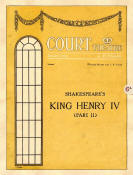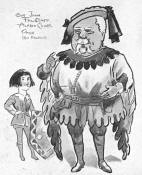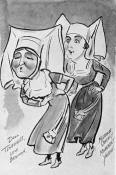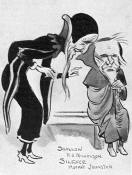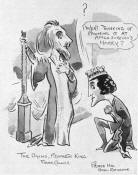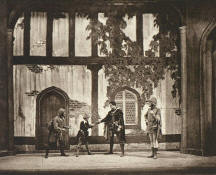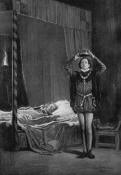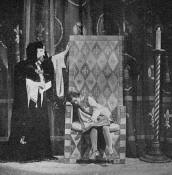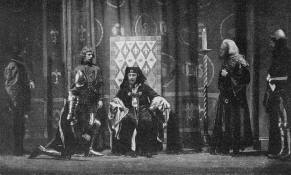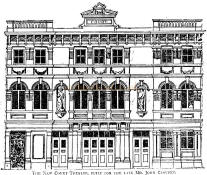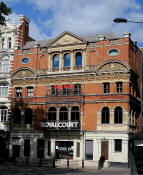King Henry IV (Part II)A drama by William Shakespeare. Opened at the Royal Court Theatre, London, February 17, 1921. Closed on April 16, 1921, after 62 performances. Director, Producer: J.B. Fagan; Lessee: William Blythe, J.B. Fagan; General Manager: A.W. Chappell; Stage manager: George Desmond; Asst. stage manager: John Collins; Scenic Design: J.B. Fagan; Scenery: R. D'Amar; Scene Builder: H.E. Hutton; Lighting: Alfred Walters; Costume Design and Creation: Theodore Komisarjevsky, Tom Heslewood; Perruquier: William Clarkson
King Henry IV, Part II, quite naturally continues the story presented in
King Henry IV, Part I. Very briefly, Part I told of a civil war between
England's King Henry IV and rebels led by Hotspur, the son of the Earl of
Northumberland. Henry was disappointed by his eldest son, Prince Hal, who
wasted his time in taverns with a group of lowlife friends. But Hal
redeemed himself by killing Hotspur in the battle of Shrewsbury, where the
king's forces were victorious. Part II begins with a prologue by Rumour, a personification of gossip and rumor, who warns that the messages it spreads are usually false and lead people to make bad decisions. Act I opens at Warkworth Castle, the home of the Earl of Northumberland, who is receiving the false news that the rebels led by Hotspur were victorious at the battle of Shrewsbury. When he learns the truth about what happened at Shrewsbury, Northumberland vows to take revenge against Henry. He sends letters to rally leaders who oppose the king. Meanwhile, in London, Prince Hal's closest friend and mentor Falstaff is in the Boar's Head Tavern, bragging that he killed Hotspur at the Battle of Shrewsbury. In reality, Prince Hal killed Hotspur, but Hal is happy to let Falstaff take the credit. Because of Falstaff's new reputation as a war hero, he isn't arrested for crimes he committed earlier. Falstaff is a drunken, lying old rascal, but he is also witty and jovial. He has definitely been a bad influence on Prince Hal, and has led him down a path of debauchery.
Meanwhile in York, several rebel leaders—including Lord Mowbray, Lord Bardolph and Lord Hastings—plot their rebellion. They wonder if they can count on Northumberland's support. They must proceed with or without Northumberland's support. Act Two opens at Westminster Castle in London, where King Henry IV is too weighed down by worry, remorse, and anxiety to sleep. King Richard II (whom Henry deposed) had predicted that Henry's rule would be one of war and betrayal. Henry is disturbed that Richard's prediction has come true.
In rural Gloucestershire, we meet two law officials who are also cousins:
Justice Shallow and Justice Silence. Their friend Falstaff arrives, looking for recruits to draft into
the king's war against the rebels in the north.
Shallow and Silence have rounded up five men for Falstaff to recruit. The two
best men bribe Falstaff to avoid service. Falstaff recruits three men named
Shadow, Wart, and Feeble, but all three are ridiculously unfit to serve in the
military.
The rebel forces have gathered in Yorkshire's Gaultree Forest to fight the king's forces, led by Prince John. The Earl of Westmoreland approaches to broker a treaty. Both sides want peace. Prince John agrees to the rebels' demands if both sides lay down their arms. But as soon as the rebel leaders have discharged their army and let the soldiers go home, Westmoreland and Prince John arrest the rebel leaders and charge them with treason. They are to be executed promptly. Meanwhile, elsewhere in the forest, Falstaff meets one of the departing rebels, who immediately surrenders to Falstaff, the famed hero of the Battle of Shrewsbury, the one who killed Hotspur (or so he thought). Prince John orders his forces back to London because he hears his father is very sick. Falstaff heads off to Gloucestershire in order to beg some money from Justice Shallow. In his palace at Westminster, the sick King is talking with his two youngest sons, Thomas and Humphrey. Prince Hal is in London with his friends. Westmoreland brings him the news that the rebel leaders have been executed.
King Henry IV is close to death. He is moved to another room, laid on the bed, and left alone
to sleep. As he sleeps, Hal arrives from the city. He goes to sit with his
father, who is sleeping so quietly that he appears to not be breathing. Thinking
that his father is dead, Hal reverentially lifts the crown onto his
own head and goes into another room to mourn. The King wakes up and, seeing the crown gone, believes that Hal doesn't
love him; he only wanted to become King. News of the king's death spreads, and everyone in the castle is worried about what will happen now that irresponsible Prince Hal is in charge. The Chief Justice is worried that he will be punished for his past treatment of Hal and his friends. What he and the others don't yet know is that Prince Hal has transformed from a wild youth to a mature, responsible adult. Hal has learned that power brings with it more responsibility, not less. Prince Hal, who will shortly be crowned King Henry V, tells his brothers not to worry. In an unexpected move, Henry acknowledges that the Chief Justice has always been wise and just, and he thanks the Justice for having disciplined him when he was a wild young prince. Moreover, he asks the Justice to serve as a father figure to him. Henry's decision to accept the Lord Chief Justice as his father figure is particularly significant. The Lord Chief Justice (one who stands for the rule of law and of responsibility) is the opposite of Falstaff, Hal's former mentor and father figure. Falstaff, meanwhile, is in Gloucestershire, having dinner with his friends Shallow and Silent. When he hears of the king’s death and Hal’s succession to the throne as King Henry V, he sets off to London to attend the coronation, expecting to be given high office at court, a reward for his friendship with Hal. In fact, Falstaff believes that all his friends also shall be rewarded for being acquaintances of Hal. Back in London, Hal is formally crowned King Henry V. When Falstaff approaches Hal on the street to greet him, the king denies knowing Falstaff. The new king says that he has changed from the wild days when he was Prince Hal; he has put that identity behind him and therefore he will have nothing more to do with Falstaff. He banishes Falstaff and his friends from court. The young king then goes to court to lay plans for an invasion of France—a story which is told in another play appropriately titled Henry V. (The plot summary above is embellished with drawings from The Illustrated Sporting and Dramatic News, March 12, 1921.)
"By the skilful elimination of the long actionless speeches, Mr. Fagan has constructed a version which is rich in Falstaffian humour and bustling fun. Indeed, I have never derived so much enjoyment from a Shakespeare revival." —The Whitstable Times and Tankerton Press, February 26, 1921 "In his production of King Henry IV Part II ..., Mr. J. B. Fagan has followed again the scholarly and artistic lines he adopted with his previous Shakespearean revivals at the Court, and this time there are no square pegs in round holes, the very lengthy cast being excellent in almost every particular. ... One of the very finest performances of all is the King Henry IV of Mr. Frank Cellier, who, after showing very skilfully the character of the quondam usurper, represented by him as with dark hair turning grey, delivers beautifully with his rich voice the rebuke to the Prince for taking the crown. Mr. Cellier's work is most impressive, and so too, as the action of the loosely-knit drama progresses, is the Prince of Wales of Mr. Basil Rathbone, who looks very picturesque." —The Stage, February 24, 1921 “In February 1921, [Laurence] Olivier went on a choir school outing to see Henry IV Part Two at the Royal Court: ‘Prince Hal. Oh, that magical Prince Hal, the most beautiful male I have ever laid eyes upon. His profile was that of a god, his figure pure Olympiad, his voice the most beautiful instrument I had yet heard, and even his name suggested the utmost in glamorous masculinity — Basil Rathbone. To me he had it all, and more, and represented a collation of theatrical virtues that I could never hope to attain.’ Hyperbole? It is the case that Olivier never played Holmes, but was a spiderish Moriarty, in The Seven Per Cent Solution.” —Roger Lewis, The Real Life of Laurence Olivier (Olivier was only 14 years old in 1921. Henry IV Part II was the first Shakespearean play that Olivier saw.)
"There was not only good elocution but good acting from Mr. Frank Cellier (King) and Mr. Basil Rathbone (Prince Henry) in the King's death-bed scene, which drew from the audience the loudest cheers of the evening. It was, indeed, a beautiful thing beautifully done. Altogether this revival—with scenery simple but sufficient, and blank verse sonorously spoken as verse—is a Shakespearian production of the richest interest." —The Times, February 18, 1921
"A remarkably good show voted a delighted many at the Court Theatre tonight, where James Fagan, collaborating with one William Shakespeare, gave us the unusual chance of enjoying "Henry IV" part II. ... The art of H.O. Nicholson, Shallow; the grace of Basil Rathbone, Hal; the disgrace of Doll Tearsheet, Bateman; and the minor excellences of Iris Hawkins were worth applause." —Truth, February 23, 1921
"The simplicity and dignity of the production, the reverence with which the play is treated, the breadth and humour of the acting are worthy of the highest praise. The actors know how to speak their words, so that we can listen without strain, and can revel in their beauty and wit. Never have the characters appeared more real or vivid to us so perfectly did the players throw themselves heart and soul into their parts, so completely was the mind free from distraction of over-elaboration of scenery or forced effects. ... Prince Hal does not appear overmuch in this second part, but Mr. Basil Rathbone made him a very picturesque figure when he was on the stage, played his wild scenes with great gusto, and his subsequent repentance with genuine feeling." —The Era, February 23, 1921
|
|||||||||||||||||||||||||||||||||||||||||||||||||||||||||||||||||||||||||||||







